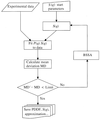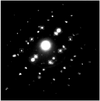issue contents
October 2000 issue

Cover illustration: Reorientation pathways of the octahedral PF6 anion in KPF6, calculated by an evolution algorithm. Courtesy of K. Knorr (University Kiel, Earth Sciences - Mineralogy) and Fritz Mädler (HMI Berlin) [J. Appl. Cryst. (1999), 32, 902-910].
research papers
The crystal structure of tetraferrocenyl-[3]-cumulene, (Fc)2C=C=C=C(Fc)2, was solved from high-resolution X-ray powder diffraction data using simulated annealing and rigid-body Rietveld refinement techniques. The crystal structure exhibits strong disorder, which can be explained by stacking faults in ordered structures.
The field of application of the direct-methods sum function is extended to cope with powder patterns with relatively large amounts of accidental overlap. This is achieved by refining not only the phases of the structure factors but also the estimated intensities of the severely overlapped peaks during the structure solution process.
Solving the indirect Fourier transformation including the structure factor requires a non-linear least-squares approach. The Boltzmann simplex simulated annealing proves to be very efficient for this task.
The crystal structure and the chemistry of a second-phase precipitate observed in combustion-synthesized NiAl were determined by transmission electron microscopy using convergent- and parallel-beam electron diffraction techniques and energy dispersive X-ray spectroscopy.
A novel device for capillary-free mounting of protein crystals, based on surrounding the crystal with an air stream of controlled humidity, is described. The system is applied for the controlled transformation of protein crystals, leading to improved crystal order and diffraction power, which might be followed by an optional shock-freezing step.
A waveguide microdiffraction setup is described for an undulator beamline at the European Synchrotron Radiation Facility. The composite optics comprise a waveguide, which confines the beam vertically, and a horizontally focusing multilayer mirror.
A diffractometer for powder samples of very small amount has been developed to collect high-quality diffraction patterns under extreme conditions. Performance, examples of application and practicability are presented.
The techniques of neutron, X-ray and electron diffraction are compared with regard to their ability to detect hydrogen ordering in superstoichiometric rare earth dihydrides. To date, only neutron diffraction has been used in such studies and has had only limited success; it is shown that electron diffraction could overcome the problems encountered in neutron experiments.
Small-angle neutron scattering (SANS) measurements have been performed on long-flight-path pinhole-collimation SANS instruments using, as a two-dimensional position-sensitive detector, both a neutron imaging plate, incorporating gadolinium, and a two-step transfer method, with dysprosium foil as the image transfer medium. The reduced pixel size of the imaging plates provides definite advantages over a conventional position-sensitive gas proportional counter in certain specific situations, namely when limited space necessitates a short sample-to-detector distance, when only small samples (comparable in size to the detector pixels) are available, or when used in conjunction with focusing beam optics.
Quantitative measurements of the peak shift, intensity and peak width of palladium nanoclusters on modifying the gaseous environment, e.g. chemisorption of oxygen, are presented. A detailed model for a palladium catalyst strongly suggests a significant contribution from icosahedral clusters that do not transform into the β-hydride phase under hydrogen.
Analysis of the diffraction profiles from thermally deposited 111-oriented gold films, ranging in thickness from 300 to 1900 Å, was performed, in combination with atomic force microscopy and transmission electron microscopy studies to provide information on the dimensions of the crystallite columns in the films and the presence of dislocations. Analysis of the magnitude and anisotropy of the observed diffraction line broadening, arising from both crystallite-size effects and dislocation-induced strain effects, indicates that the dislocations have a mixed screw/edge character and tend to form primarily on (111) slip planes parallel to the substrate at densities of ∼1015 to 1016 m−2.
Using the kinematical theory of X-ray scattering by crystals with dislocations as developed by Krivoglaz et al. and Wilkens, the dislocation content of compressed copper single and polycrystals was investigated by means of profile analysis of selected diffraction peaks.
teaching and education
Free 

A discussion of why the idea of the number of `good' intensities in a powder pattern is more appropriate than the notion of `independent' ones, with a related tutorial on the underlying concepts of correlation and covariance, is presented.
crystallographers
Free 



 journal menu
journal menu
































